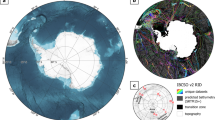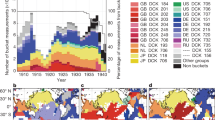Abstract
EVER since Wegener published in 1915 his remarkable theory of the drift of the continents and the movement of the poles, most of us have viewed a map of the world with entirely different eyes, and it has become almost instinctive to look for correspondences between the outlines of the continents and relationships between the continents and the oceans.
This is a preview of subscription content, access via your institution
Access options
Subscribe to this journal
Receive 51 print issues and online access
$199.00 per year
only $3.90 per issue
Buy this article
- Purchase on Springer Link
- Instant access to full article PDF
Prices may be subject to local taxes which are calculated during checkout
Similar content being viewed by others
Author information
Authors and Affiliations
Rights and permissions
About this article
Cite this article
SIMPSON, G. Continents and Oceans. Nature 124, 837–838 (1929). https://doi.org/10.1038/124837a0
Issue Date:
DOI: https://doi.org/10.1038/124837a0
Comments
By submitting a comment you agree to abide by our Terms and Community Guidelines. If you find something abusive or that does not comply with our terms or guidelines please flag it as inappropriate.



